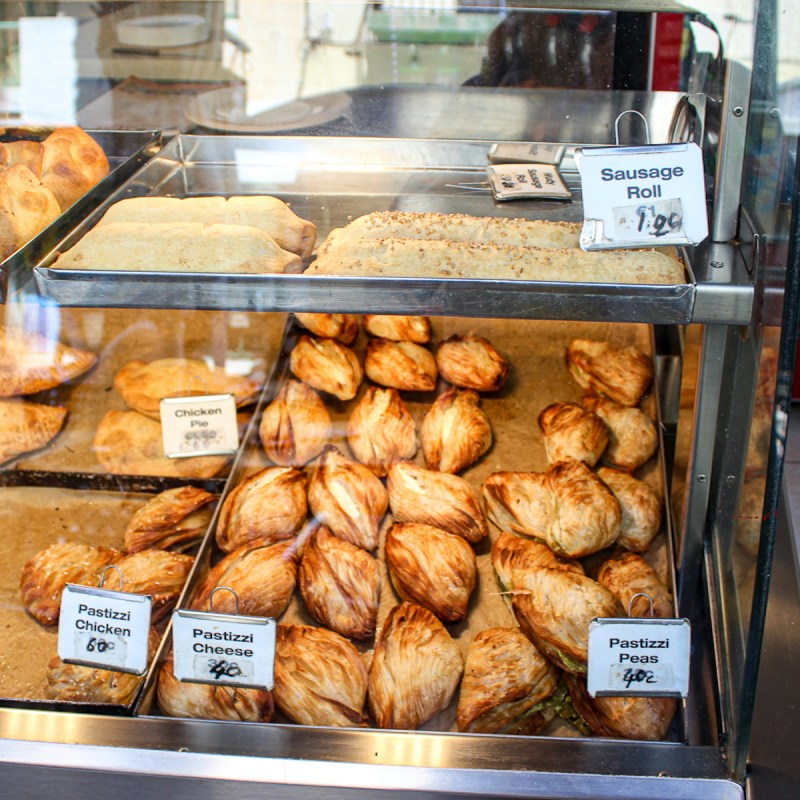
The out-of-the-way lido was far below a limestone terrace and white umbrellaed café. A sheltered cove opened into the impossibly blue Mediterranean, looking over the Gozo Channel to the island of Malta. A courageous young man dove from the terrace. Seabirds fed small fish to chicks in cliffside nests.
Videos by TravelAwaits
The waiter brought a tray of fish and king prawns on ice. The bounty was caught in the cove below me that morning. I chose a small Pagella (red snapper) to be grilled whole. I listened to my fish sizzle and sipped a glass of Maltese bubbly. Then, as I daydreamed and gazed across the blue water, small plates with olives, bread, cheese, sausage, and beans began filling my table. That’s when I fell in love with Maltese food.
Eating Malta
While in Malta, I didn’t eat one unappetizing or poorly cooked morsel. Restaurants, cafés, markets, and street vendors sell fresh, locally produced meat, fish, vegetables, fruit, and dairy.
I fell in love with the Mediterranean diet because the food is seasonal and always fresh. I tried street food, sidewalk cafés, four-star restaurants, and buffets. I bought food for picnics and groceries at farmer’s markets, village shops, mobile fishmongers, traveling farmers, and supermarkets. I was never disappointed.
When you go to Malta, try everything. They’re all delightful but don’t miss these 15 favorites of mine.

1. Pastizzi
This is Malta’s staple street food. Shell-shaped layers of flakey pastry enclose savory ricotta or, my favorite, perfectly seasoned peas. Malta is known for their pastries, both sweet and savory. Pastizzi is a favorite with mid-morning tea. Stop in a small bakery or kiosk filled with locals drinking tea, eating pastizzi, and catching up on neighborhood gossip.
Available at coffee shops, bakeries, and kiosks, you will quickly find your favorite spot for this tender pastry filled with creamy cheese. Ask a local where they get their pastizzi and begin your quest to find the best.

2. Pizzette
Yes, it is very much like pizza, but it’s Maltese pizza. Like any country, Malta has several versions of favorite dishes. The pizzette differs from island to island; even villages may have their own special recipe.
The pizzette pictured above is the most common type. The crust is made from Maltese wheat. It’s an ancient grain brought to the islands by the Romans in 218 BC. The flour yields a crisp crust that fires beautifully in the traditional wood ovens. It’s topped with olive oil, tomatoes, thinly sliced potatoes, olives, and tuna. You’ll find this delight in many versions at bakeries, kiosks, and delis.
Pro Tip: Look for a kiosk while you are out and about exploring towns and villages. They are widespread. Kiosks are fast food stands that serve prepared pastries, pizzas, rolls, sandwiches, meat pies, and other traditional street foods. The food is always delicious and budget-friendly. For example, you can have a filling lunch from the kiosk with a pizzette and a cold Cisk (Maltese lager) for €2.50.

3. Seafood And Shellfish
Seafood is Malta’s primary protein. Fins and shells come into Malta from the small fishing villages surrounding the island daily. Often in the daily catch are Lampuka (Mahi-Mahi), swordfish, seabass, grouper, sea bream, shrimp, king prawns, mussels, clams, oysters, and urchins.
You will find fish on all Malta menus. I especially recommend pasta with seafood. Seafood linguini is popular. The seafood will vary with the day’s catch. Kiosks will have a fish pie or pizzette. Food shops and fishmongers have the day’s catch available to take home for a feast.

4. Stuffat Tal-Fenek
Stuffat tal-fenek, or Rabbit Stew, is the national dish of Malta. Locally raised rabbit is slow-cooked with red wine, tomato paste, garlic, carrots, and potatoes. The rich stew is served with mashed potatoes and vegetables. You’ll find it on menus in most Maltese eateries.
5. Maltese/Italian Everything
Malta is 60 miles from Sicily. The two countries have been connected for thousands of years. Similar climates produce similar food. Maltese food has a strong Italian influence, or perhaps it’s the other way round. Regardless, the two cuisines share similarities.
When you find a favorite Italian dish such as lasagna on the menu, give it a try. You will discover subtle differences that show you a new side to your old favorites. I especially like the tomato sauces made in Malta. They are a bit lighter and less acidic. Pasta is usually made from local wheat, adding a more robust flavor. You will find Maltese/Italian food on every menu, kiosk, and food shop.

6. A Sample Of Malta
The Maltese Platter will most likely be your first taste of Malta. Most restaurants will bring a plate of traditional Maltese noshes to your table after you have ordered and before your starter. The complimentary amuse-bouche comes in many varieties depending on the season and restaurant style. The size depends on the number of diners.
The small plates that are offered are often complimentary. Listed on the menu, large platters with a wide variety of locally produced delicacies will include a charge.
Restaurants everywhere serve a Malta platter. However, eateries in tourist areas will be more likely to have a group-sized platter.

7. Bigilla (Maltese Bean Paste)
This savory spreadable dip is made from tic beans, called ful ta’ Ġirba (Djerba beans). The cooked beans are mashed with herbs like mint, marjoram, peppers, garlic, and lemon. Some puree the mixture silky smooth, while others leave it slightly chunky. Either way, it’s a delightful spread on Maltese bread or traditional water crackers. Bigilla is often on Malta Platters. Delis and food shops are also a good source of the Maltese classic.

8. Hobz Biz-Zejt
One of the oldest dishes on the islands, hobz biz-zejt is Maltese bread with oil and tomatoes. Traditional crunchy Maltese sourdough bread is coated with local olive oil, then spread with sweet or spicy tomato paste. This tomato paste is unlike what you find in cans in American supermarkets. Made only from Maltese grown and sundried tomatoes, the flavor is umami and robust with a sweet note that is the underlying background of many Maltese dishes.
Pro Tip: Hobz biz-zejt comes in such wide varieties that it’s confusing. Try it when you see it on a menu; you won’t be disappointed. Often served as an open-faced sandwich, it may come with a Mediterranean salad on top or maybe tuna or sausage on top of the salad.
9. Broad Beans
On menus and in shops, I look for broad beans — one of Malta’s largest crops. They are enjoyed fresh, dried, and pickled. Most soups and stews will contain beans. In addition, Malta platters may have pickled broad beans and a bean paste.

10. Goat Cheese
Maltese cheese may be natural or spiced with peppers and herbs in fresh and aged varieties. Most are mild in flavor, but tangy types are on offer. I’m crazy for the fresh goat cheese. It’s mild and creamy. Fresh, soft cheeses are well-liked as a spread on bread with olive oil. Maltese cheese is ubiquitous and very inexpensive in markets.
Pro Tip: Don’t be surprised to see a herd of goats being herded to the milking parlor through village streets. Goats are frequently moved to pastures for grazing. Whether walking or driving, move aside; the goats have the right of way.

11. Olives And Olive Oil
Olives harvested in Gozo, Malta are one of my favorite crops. I’ve walked through olive groves with trees that are centuries old. They are an essential part of the daily diet. Used for oil and as food, unique varieties are grown in Malta. They may be fresh, pickled, or stuffed with anchovy paste, garlic, or peppers. Olives and olive oil are available in restaurants, markets, and food shops.

12. Maltese Sausage
The sweet or savory sausage is typically made from pork and spices. Although, you may find some made from rabbit or goat. It will be cured or even smoked. Find it in restaurant dishes, local markets, and farmer’s markets.
13. Tomato Paste
You haven’t tasted a tomato until you’ve savored one grown in Gozo. The sea air and endless sunshine make Malta perfect for harvesting tomatoes. At farmers markets, you will be surprised at the endless types. Tomatoes on your plate may be fresh, sundried, or cooked in a sauce using the delicious tomato paste. You will find tomato paste in food shops, delis, and markets.
14. Figs And Dates
Figs and dates are grown in Malta in several varieties. These sweet treats can be found in desserts and savory dishes. You’ll discover figs and dates in restaurants, markets, and food shops. I like them for dessert with fresh goat cheese and a squeeze from a ‘perpetual lemon,’ the most common in Malta. The perpetual lemon bears fruit year-round.

15. Libations
The Maltese have been making wine and beer for centuries. They had some excellent teachers over the millennia, especially the Romans. Among many types, Girgentina is a widely cultivated wine grape. It has been grown there for centuries, but its exact origin is unknown. It’s used for white table wine and my favorite bubbly.
A wide variety of Maltese wine such as red, white, and sparkling are available everywhere that serves food, from kiosks to five-star restaurants. Markets and food shops are good sources to fill your larder or picnic basket with local wine at prices that will make you smile. Try Ta Mina in Gozo and Ta Betta in Malta for an authentic taste of Malta in a wine glass.
When you say beer in Malta, you say, “Cisk.” The smooth pilsner has been Malta’s favorite since 1929. Available in six styles, the most popular is pilsner. It pairs well with most foods and makes a lovely afternoon cooler. You’ll find Cisk everywhere food is served like bars, kiosks, and shops.
When You Eat In Malta
You can’t go wrong in Malta when it comes to food. With each bite and every sip, you’ll taste the passion the Maltese have for growing and preparing the Mediterranean’s bounty. Eating is a slow adventure in the Mediterranean; take your time, savor, and immerse into Malta’s unforgettable food.
Click here for more resources on traveling to Malta:
